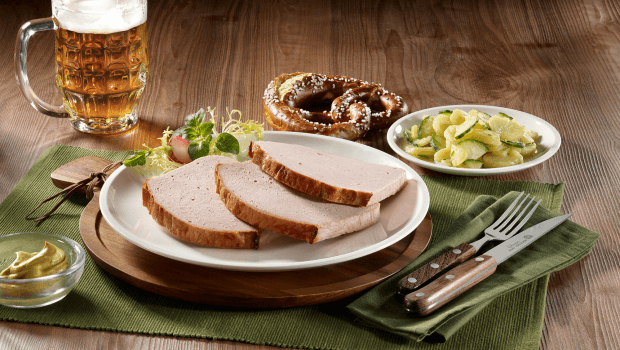
Leberkäse: The delicacy of the meaty bread.
It is a speciality food of Germany, Austria and Switzerland and holds similarity with bologna sausages and holds specific popularity in the regions of Swabia, Bavaria and Franconia. Moreover, Leberkäse is known as Fleischkäse in Saarland, Baden, Switzerland and Tyrol. It literally means “liver cheese” and the dish comprises of corned beef, pork, bacon and onions – by grinding them very finely and finally baking the mixture as you would a loaf of bread in the bread pan itself till the crust becomes crunchy.
Understanding the meatloaf culture of Germany
Food and food products in Germany undergo rigorous examination under the German Food Manual. Moreover, the content of liver is limited to 5% in Stuttgart whereas in Bavaria there is no mandate on the liver content. Some households use the liver while others don’t and the marketed ones also do not have any liver content. These specifications are present so that the customers are not duped off but also to preserve the specific tastes of the various regions.
In Bavaria you can find a 200 year old history of Leberkäse. It gets its name because of the dense cheese like consistency and it does not contain cheese and liver in most regions. You will rarely find Leberkäse in the markets of Bavaria which have any liver content. Here it can be found by the name of Bavarian Leberkäse.
What is Leberkäse?
Somewhere in 1776 lies the birth of Leberkäse and also arguably in the region of Bavaria. It has been often translated as “liver cheese” because of the earlier recipe which included liver as a main ingredient and then the texture thus would come out as that of cheese. Moreover, as the recipe got metamorphosed, liver went out but with the meaty concentration it became termed as: meat-cheese or Fleischkäse. Though, you can also find liver content in Fleischkäse found in some parts of Bavaria and largely Stuttgarter, the main difference lies in the percentage content of liver.
Furthermore, there is not just one way of eating the Fleischkäse. For instance they can be eaten with:
- Semmel: Also known as bread roll, this is the traditional way of serving Fleischkäse. The seasoning consists of mustard or a variety of pickle. You can easily find it in fast food stalls, butcher shops and super markets in South-Germany and Austria by the name of Leberkäsesemmel or Leberkäsweggla. Its popularity has made it into a staple of the region. There are many stores which serve their own variant of Leberkäse.
- Finger-thick slices: Sometimes they are served by cutting the bread in the form of finger thick slices or like thick french-fries and served with mustard or the famous Bavarian sweet mustard and ketchup as well. Soft pretzels, Sauerkraut, or potato salads (Kartoffelsalat) are the usual accompaniments of the main dish.
- Pan fried: In this case the bread is fried till the brown color appears and served along with fried eggs and/or German potato salad.
- Sandwiches: They are quite popular sandwich fillings along with pickled cucumbers as seasoning.
- The combination style: Here, the bread is cut into thin slices along with cheese and slices of ham then this is dipped into eggs, coated with breadcrumbs and finally fried in a pan. You can find this by the name of falsches Cordon Bleu or mock Cordon Bleu.
The other popular variants are as follows:
- Käseleberkäse: This requires small bits of cheese which are evenly distributed in the mixture.
- Pikanter Leberkäse: This would require you to add chunks of bell peppers and pickles into your sandwich.
- Pizzaleberkäse: For this, you’ll be required to add cheese, bell peppers, pickles, along with salalmi. This would more or less look like a pizza.
- Pferdeleberkäse: Made quite literally from horse meat and is quite a delicacy in European regions where German is spoken.
